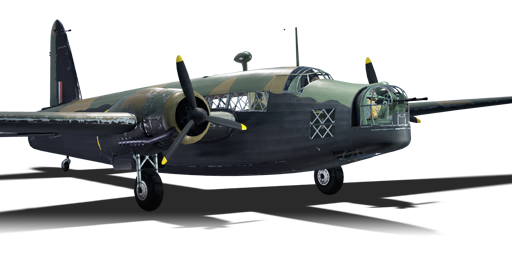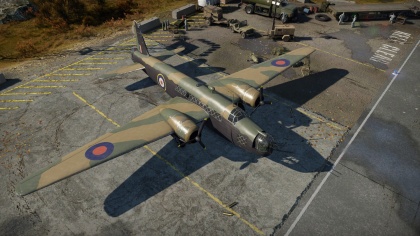Wellington Mk Ic
Contents
| This page is about the British bomber Wellington Mk Ic. For the German version, see Wellington Mk Ic (Germany). For other uses, see Wellington (Family). |
Description
The Wellington Mk Ic is a rank British bomber
with a battle rating of (AB), (RB), and (SB). This aircraft has been in the game since the start of the Open Beta Test prior to Update 1.27.
General info
Flight Performance
Describe how the aircraft behaves in the air. Speed, manoeuvrability, acceleration and allowable loads - these are the most important characteristics of the vehicle.
| Characteristics | |||||||
|---|---|---|---|---|---|---|---|
| Stock | |||||||
| Max Speed (km/h at 4,572 m) |
Max altitude (meters) |
Turn time (seconds) |
Rate of climb (meters/second) |
Take-off run (meters) | |||
| AB | RB | AB | RB | AB | RB | ||
| 366 | 352 | 36.0 | 37.2 | 4.2 | 4.1 | 877 | |
| Upgraded | |||||||
| Max Speed (km/h at 4,572 m) |
Max altitude (meters) |
Turn time (seconds) |
Rate of climb (meters/second) |
Take-off run (meters) | |||
| AB | RB | AB | RB | AB | RB | ||
| 391 | 378 | 34.1 | 35.0 | 6.5 | 5.3 | 877 | |
Details
| Features | ||||
|---|---|---|---|---|
| Combat flaps | Take-off flaps | Landing flaps | Air brakes | Arrestor gear |
| ✓ | ✓ | ✓ | X | X |
| Limits | ||||
|---|---|---|---|---|
| Wing-break speed (km/h) |
Gear limit (km/h) |
Combat flaps (km/h) |
Max Static G | |
| + | - | |||
| 355 | ~5 | ~3 | ||
| Optimal velocities | |||
|---|---|---|---|
| Ailerons (km/h) |
Rudder (km/h) |
Elevators (km/h) |
Radiator (km/h) |
| < 275 | < 275 | < 310 | > 320 |
| Compressor (RB/SB) | ||
|---|---|---|
| Setting 1 | ||
| Optimal altitude | 100% Engine power | WEP Engine power |
| 900 m | 1,005 hp | 1,005 hp |
| Setting 2 | ||
| Optimal altitude | 100% Engine power | WEP Engine power |
| 3,920 m | 890 hp | 890 hp |
Survivability and armour
Examine the survivability of the aircraft. Note how vulnerable the structure is and how secure the pilot is, whether the fuel tanks are armoured, etc. Describe the armour, if there is any, and also mention the vulnerability of other critical aircraft systems.
Armaments
Suspended armament
The Wellington Mk Ic can be outfitted with the following ordnance:
- 10 x 250 lb G.P. 250 lb Mk.IV bombs (2,500 lb total)
- 18 x 250 lb G.P. 250 lb Mk.IV bombs (4,500 lb total)
- 9 x 500 lb G.P. 500 lb Mk.IV bombs (4,500 lb total)
- 2 x 1,000 lb AN-M65A1 bombs + 6 x 250 lb G.P. 250 lb Mk.IV bombs (3,500 lb total)
- 2 x 18 inch Mark XII torpedoes
- 1 x 4,000 lb H.C. 4,000 lb Mk.II bomb (4,000 lb total)
Defensive armament
The Wellington Mk Ic is defended by:
- 2 x 7.7 mm Browning .303 machine guns, nose turret (1,200 rpg = 2,400 total)
- 2 x 7.7 mm Browning .303 machine guns, rear turret (2,000 rpg = 4,000 total)
- 1 x 7.7 mm Vickers K machine gun, 2 x side turrets (483 rpg)
Usage in battles
Wellingtons are great Rank 2 turret platforms, with wide arcs and stable flight. If your flight controls are shot out, adjustment of engine power will allow stable flight and more opportunities to fight back. Just remember it only has 7.7 mm (.303 in) MGs so it is more luck to earn kills with them.
As with all bombers, crew training with at least Expert Qualification is important for profitable missions.
Both the UK Wellington and German Mk I’s (Jelly Welly) are identical.
Tactics
In AB the winning tactic is to climb high and do base bombing with 500’s from orbit; it helps to have escorts.
In RB you start in the air so you have the advantage to trade altitude for airspeed, bomb ground targets and retreat before enemy fighters arrive, however be close to friendlies so they can intercept chasers.
Counter-tactics
If you are attacking a Wellington, focus on its engines, they are relatively easy to set on fire. While you should not worry too much about its turrets, do not hang around either, as an attack could still be dangerous.
Manual Engine Control
| MEC elements | ||||||
|---|---|---|---|---|---|---|
| Mixer | Pitch | Radiator | Supercharger | Turbocharger | ||
| Oil | Water | Type | ||||
| Not controllable | Controllable Not auto controlled |
Not controllable Not auto controlled |
Controllable Not auto controlled |
Combined | Controllable 2 gears |
Not controllable |
Modules
| Tier | Flight performance | Survivability | Weaponry | ||
|---|---|---|---|---|---|
| I | Fuselage repair | Radiator | Turret 7 mm | TC mk.I | |
| II | Compressor | Airframe | New 7 mm MGs (turret) | LBC mk.I | |
| III | Wings repair | Engine | New 7 mm MGs (turret) | SBC mk.I | |
| IV | Engine injection | Cover | MBC mk.I | ||
The default bomb load is a meagre 10 x 250 lb (117 kg) so upgrading to 18 x 250 or 9 x 500 pounders (500 lb (226 kg)) should be task number one. In order: unlock the Turret 7 mm ammo first, then the TC mk.I (torpedo) rack, and then the LBC mk.I. Unlocking the 7 mm ammo gives access to the Universal AP-I belt as one works up to the bomb racks for 18 x 250 or 9 x 500. After that you can pursue your choice of upgrades.
Upgrades to the turret should also be considered. The different belts do not have a considerable effect, but the upgraded turrets allow for a longer rate of fire. Very important for the small rifle calibre machine guns.
However, speed and climb rate is also a necessity and the unlocks help the sluggish Wellington a lot. The decision should depend on the pilots flying style. When rushing in better armament will help in the retreat, but the better performance will aid even more to get to friendly zones.
The sneaky approach on the other hand relies less on speed, but on surviving the random combat encounters. Turret upgrades are the way to go for this playstyle.
Pros and cons
Pros:
- Excellent payload - 4,500lbs at max.
- Versatile payload options.
- Devastating to enemy bases/airfields when unopposed.
- Excellent turret coverage.
- Very powerful torpedoes, two are enough to sink an aircraft carrier.
- Access to the devastating 4000 lb bomb.
- The aircraft can take a beating thanks to the cross hatched air frame.
Cons:
- Defensive turrets are easy to take out.
- Defensive armament is poor.
- Extremely slow all-around mobility.
- Easy prey for high altitude fighters/try to get near 6000m where very little opposition is found.
- Having a fighter with good weaponry on your six usually means death.
- The crew cannot take a beating thanks to there being no armour. The cockpit is particularly vulnerable.
History
Performance wise the Willington was not notably remarkable, its strength lay on the inside. Devised by one of the greatest innovative thinkers in history, Sir Barnes Neville Wallis devised a geodesic structure resulting in an exceptionally strong airframe. Together with Reginald Kirshaw "Rex" Pierson they designed their record making Vickers Wellesley, opening the way for the Wellington and larger Warwick. With high aspect ratio wing and spacious fuselage it proved capable of handling a myriad of missions including early airborne radar and robust enough enough to absorb severe damage and fly home. Although the bomb bay configuration limited bomb size its payload was slightly more than the Heinkel He-111H-3 and with greater range. It is also one of the first aircraft to have a powered turret in the extreme tail with a very wide arc; however it still was inadequate to defend itself against attacking fighters and early models lacked self sealing fuel tanks. Still, this aircraft was admired by crews and affectionately called Wimpy after Popeye’s hamburger loving friend and sidekick who's full name is J. Wellington Wimpy. Over 11,000 made, it equipped many RAF squadrons including those comprised of foreign crews like the Polish (4 squadrons), New Zealand (No. 75), and Czech (No, 311) one of which was captured by Germans who used it for intelligence and training. Viking, a passenger transport variant, became the world's first pure jet transport prototype aircraft in 1948.
Media
Excellent additions to the article would be video guides, screenshots from the game, and photos.
See also
Links to the articles on the War Thunder Wiki that you think will be useful for the reader, for example:
- reference to the series of the aircraft;
- links to approximate analogues of other nations and research trees.
External links
Paste links to sources and external resources, such as:
- topic on the official game forum;
- encyclopedia page on the aircraft;
- other literature.
| Britain bombers | |
|---|---|
| Torpedo | Swordfish Mk I · Swordfish Mk II · ▄Avenger Mk II |
| Dive | V-156-B1 |
| Hydroplanes | ▄Catalina Mk IIIa · Sunderland Mk IIIa · Sunderland Mk V |
| Light | Blenheim Mk IV · Beaufort Mk VIII · ▄Hudson Mk V · Brigand B 1 |
| Based on A20 | ▄Havoc Mk I · ▄Boston Mk I · ▄DB-7 |
| Hampden | Hampden Mk I · Hampden TB Mk I |
| Wellington | Wellington Mk Ic · Wellington Mk Ic/L · Wellington Mk III · Wellington Mk X |
| Halifax | Halifax B Mk IIIa |
| Stirling | Stirling B Mk I · Stirling B Mk III |
| Lancaster | Lancaster B Mk I · Lancaster B Mk III |
| Lincoln | Lincoln B Mk II |
| Shackleton | Shackleton MR.Mk.2 |





